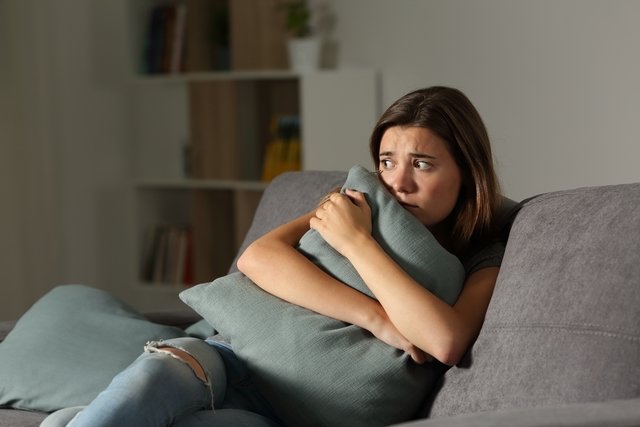A phobia is the irrational fear or aversion of something or some situation, which leads to the appearance of anxiety symptoms, such as tremors, increased heart rate, cold sweat, paleness, flushing, muscle tension, panic and fainting, for example.
It is possible for a person to have more than one specific phobia, such as fear of storms and fear of flying, for example, so symptoms may be more intense when exposed to situations that trigger different phobias.
It is important that the type of phobia is identified, as this allows the psychologist to begin the most appropriate treatment, which can be through the cognitive-behavioral method or through exposure therapy. In some cases, it may also be recommended that a psychiatrist be consulted to assess the need to use medication to control symptoms.

Main phobias
The most common phobias are:
1. Tripofobia
Trypophobia, also known as fear of holes, occurs when you feel discomfort, itching, tremors, tingling and repulsion when in contact with objects or images that have holes or irregular patterns, such as honeycombs, groups of holes in the skin, wood , plants or sponges, for example. In more serious cases, this contact can cause nausea, increased heart rate, and even lead to a panic attack.
According to recent research, this happens because people with trypophobia make an unconscious mental association between these patterns and a possible dangerous situation and fear arises, most of the time, in patterns created by nature.
The repulsion felt is due to the similarity of the appearance of the holes with worms that cause skin diseases or with the skin of poisonous animals, for example. See how trypophobia is treated.
Don’t ignore the signs your body is giving you!
2. Agoraphobia
Agoraphobia is characterized by the fear of staying in open or closed spaces, using public transport, standing in line or being in a crowd, or even leaving home alone. In these situations, or when thinking about them, people with agoraphobia feel anxiety, panic, or have other disabling or embarrassing symptoms.
The person who is afraid of these situations avoids them or faces them with great fear and anxiety, needing the presence of a company to endure them without fear. In these cases, the person is constantly worried about suffering panic attacks, losing control in public or something happening that puts them in danger. Learn more about agoraphobia.
3. Social phobia
Social phobia, or social anxiety disorder, is a psychological disorder in which a person experiences excessive anxiety and fear when faced with situations in which they could be negatively evaluated for their performance or for what other people will say or think about them. .
Generally, these people feel inferior, have low self-esteem, are afraid of being attacked or embarrassed by others, and have probably in the past gone through traumatic experiences such as bullying, aggression, or been under a lot of pressure from parents or teachers.
The most common symptoms of social phobia are anxiety, increased heart rate, difficulty breathing, sweating, red face, shaking hands, dry mouth, difficulty speaking, stuttering and insecurity. Furthermore, the person is also very worried about their performance or what people might think of them. Social phobia can be cured if treated properly. Find out more about social phobia.
4. Claustrophobia
Claustrophobia is a type of psychological disorder in which a person is afraid of being in closed places, such as elevators, very crowded buses or small rooms, for example. People with claustrophobia believe that the space they are in is getting smaller, thus developing symptoms of anxiety such as excessive sweating, dry mouth and increased heart rate.
The causes of this phobia may be hereditary or associated with a traumatic episode in childhood, in which the child was locked in a room or in an elevator, for example.
5. Arachnophobia
Arachnophobia, also known as the fear of spiders, is one of the most common phobias, and happens when a person has an exaggerated fear of being close to arachnids, causing them to lose control, and may also feel dizzy, increased heart rate, chest pain, feeling short of breath, tremors, excessive sweating, thoughts of death and nausea.
The causes of arachnophobia are not known for sure, but it is believed that it could be an evolutionary response, as the most venomous spiders cause infections and diseases. Thus, the fear of spiders is a kind of unconscious defense mechanism of the body, to avoid being bitten.
Thus, the causes of arachnophobia can be hereditary, or be associated with the fear of being bitten and dying, or seeing other people with the same behavior, or even due to traumatic experiences with spiders in the past.
6. Coulrofobia
Coulrophobia is characterized by an irrational fear of clowns, in which the person feels traumatized by the sight of them, or just imagining their image.
It is believed that fear of clowns may begin in childhood, because children are very reactive to strange people, or due to an unpleasant episode that may have happened with clowns. Furthermore, the simple fact of the unknown, of not knowing who is behind the mask, causes fear and insecurity. Another cause of this phobia could be the way in which evil clowns are represented on television or in the cinema, for example.
Although it is seen by many as a harmless game, clowns cause symptoms such as excessive sweating, nausea, rapid heartbeat, rapid breathing, crying, screaming and irritation in people with coulrophobia.
7. Acrofobia
Acrophobia, or fear of heights, consists of an exaggerated and irrational fear of high places such as bridges or balconies of tall buildings, for example, especially when there is no protection.
This phobia can be triggered by a trauma experienced in the past, by exaggerated reactions by parents or grandparents whenever the child was in high places, or simply by survival instinct.
In addition to the symptoms common to other types of phobia such as excessive sweating, tremors, shortness of breath and increased heart rate, the most common symptoms of this type of phobia are inability to trust one’s balance, constant attempts to hold on to something, crying and screams.
8. Thalassophobia
Thalassophobia is the intense and persistent fear of the sea, ocean or lake, especially when it is deep. This type of phobia can cause symptoms such as tremors, shortness of breath, palpitations, excessive sweating and chest pain, for example.
9. Fatphobia
Fatphobia is a type of phobia characterized by discrimination against overweight people due to their body constitution. This type of phobia can cause various social, personal and emotional consequences for the person, as it interferes with different aspects of their life. Find out more about fatphobia.

Sign up for our newsletter and stay up to date with exclusive news
that can transform your routine!
Warning: Undefined array key "title" in /home/storelat/public_html/wp-content/plugins/link-whisper-premium/templates/frontend/related-posts.php on line 12
Warning: Undefined array key "title_tag" in /home/storelat/public_html/wp-content/plugins/link-whisper-premium/templates/frontend/related-posts.php on line 13



